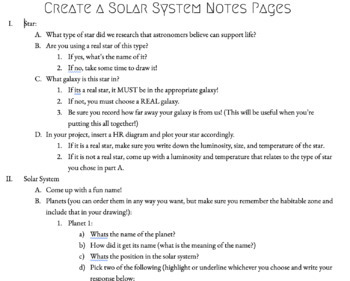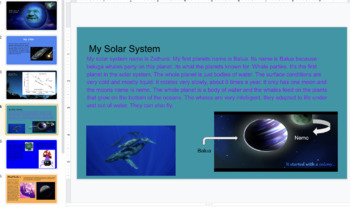Design a Solar System Project
Olivia Vilardi-Perez
3 Followers
Grade Levels
8th - 12th
Subjects
Resource Type
Standards
NGSSMS-ESS1-2
NGSSHS-ESS1-1
Formats Included
- Google Drive™ folder
Olivia Vilardi-Perez
3 Followers

Made for Google Drive™
This resource can be used by students on Google Drive or Google Classroom. To access this resource, you’ll need to allow TPT to add it to your Google Drive. See our FAQ and Privacy Policy for more information.
What educators are saying
Thank you! This was a perfect replacement for my single planet project I used to do with 9th-grade heart science. Now that it has moved to upperclassmen I needed something a bit more in-depth and this fit the bill and tied all the astronomy units together nicely!
Description
In this culminating project, students demonstrate their understanding of the life cycle of a star, the formation of the solar system, and various aspects in Astronomy. Students are asked to design their own solar system using a known OR made up star and explaining the star based on the HR Diagram. There is a minimum requirement of 6 planets, one requiring moons and another requiring life forms.
This google drive folder includes the following resources:
- Project description page (editable)
- Project rubric (editable)
- Project note page (editable - breaks down what students need for each task)
- Information on Extremophiles (editable)
- Three samples (one teacher made utilizing our solar system and two made by students with their imagination and some original art!)
This project is easily molded into what you need it to be. I utilized this with my special ed general science course and edited as needed for students with IEPs. Students had a blast designing their own solar system!
Total Pages
Answer Key
Rubric only
Teaching Duration
1 Week
Report this resource to TPT
Reported resources will be reviewed by our team. Report this resource to let us know if this resource violates TPT’s content guidelines.
Standards
to see state-specific standards (only available in the US).
NGSSMS-ESS1-2
Develop and use a model to describe the role of gravity in the motions within galaxies and the solar system. Emphasis for the model is on gravity as the force that holds together the solar system and Milky Way galaxy and controls orbital motions within them. Examples of models can be physical (such as the analogy of distance along a football field or computer visualizations of elliptical orbits) or conceptual (such as mathematical proportions relative to the size of familiar objects such as students’ school or state). Assessment does not include Kepler’s Laws of orbital motion or the apparent retrograde motion of the planets as viewed from Earth.
NGSSHS-ESS1-1
Develop a model based on evidence to illustrate the life span of the sun and the role of nuclear fusion in the sun’s core to release energy that eventually reaches Earth in the form of radiation. Emphasis is on the energy transfer mechanisms that allow energy from nuclear fusion in the sun’s core to reach Earth. Examples of evidence for the model include observations of the masses and lifetimes of other stars, as well as the ways that the sun’s radiation varies due to sudden solar flares (“space weather”), the 11-year sunspot cycle, and non-cyclic variations over centuries. Assessment does not include details of the atomic and sub-atomic processes involved with the sun’s nuclear fusion.




